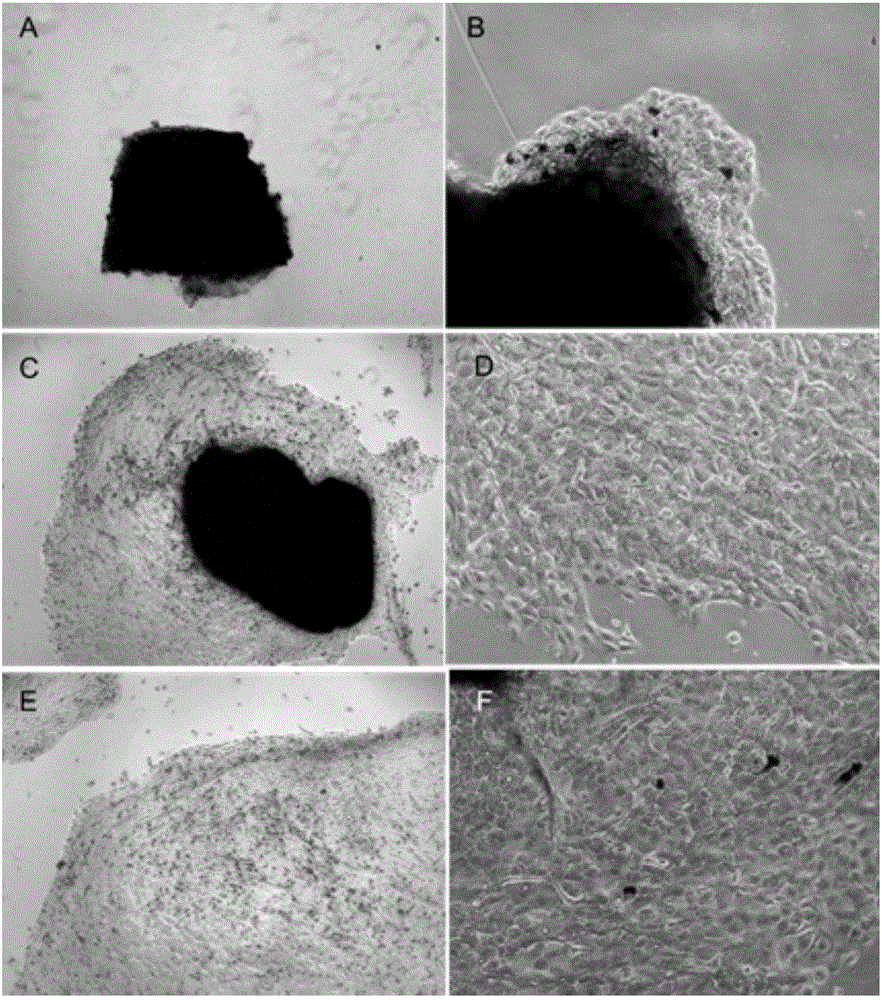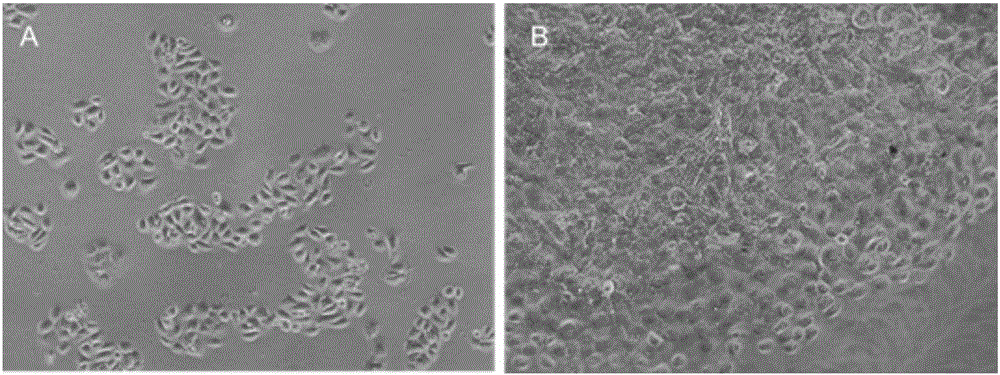Method for separating, cultivating and identifying skin epithelial cell of giant salamander
A technology of epidermal cells and identification methods, which is applied in the field of separation, cultivation and identification of giant salamander skin epidermal cells, and can solve the problems that the separation of giant salamander skin epidermal cells has not been reported.
- Summary
- Abstract
- Description
- Claims
- Application Information
AI Technical Summary
Problems solved by technology
Method used
Image
Examples
Embodiment 1
[0032] The method for separating and cultivating giant salamander skin epidermal cells that the present invention adopts comprises the following steps:
[0033] (1) After fixing the living giant salamander, cut off the skin tissue of about 1 cm × 1 cm in size from its tail, and immediately put it into a pre-cooled 4°C culture medium containing double antibodies (penicillin 500 U / mL, streptomycin 0.5 mg / mL). 60% PBS buffer (dilute the PBS buffer with high-pressure sterilized ultrapure water to a PBS volume fraction of 60%), and transport it to the laboratory ultra-clean workbench within 10 minutes;
[0034] (2) scrape off the mucus on the surface of the giant salamander skin tissue in PBS with ophthalmic tweezers in the ultra-clean workbench, and soak it in 75% alcohol by volume for 10 seconds;
[0035] (3) Wash 6-8 times with 60% PBS buffer solution pre-cooled at 4°C and added with double antibodies (penicillin 500U / mL, streptomycin 0.5mg / mL), and put it into a sterilized ampo...
Embodiment 2
[0043] The method for separating and cultivating giant salamander skin epidermal cells that the present invention adopts comprises the following steps:
[0044] (1) After fixing the living giant salamander, cut off the skin tissue of about 1 cm × 1 cm in size from its tail, and immediately put it into a pre-cooled 4°C culture medium containing double antibodies (penicillin 500 U / mL, streptomycin 0.5 mg / mL). 60% PBS buffer solution, transported to the laboratory ultra-clean workbench within 10 minutes;
[0045] (2) scrape off the mucus on the surface of the giant salamander skin tissue in PBS with ophthalmic tweezers in the ultra-clean workbench, and soak it in 75% alcohol by volume for 10 seconds;
[0046] (3) Wash 6-8 times with 60% PBS buffer solution pre-cooled at 4°C and added with double antibodies (penicillin 500U / mL, streptomycin 0.5mg / mL), and put it into a sterilized ampoule;
[0047] (4) Use ophthalmic scissors to cut the giant salamander skin tissue into tissue blo...
Embodiment 3
[0057] The present invention uses the giant salamander skin epidermal cells obtained in Example 1 to sequence the giant salamander K5, K10 and P63 genes, including the following steps:
[0058] (1) Primer design
[0059] Since the K5, K10 and P63 gene sequences of giant salamander have not been published yet, we first select species with high homology to giant salamander, and then search the K5, K10 and P63 gene sequences of these species in the NCBI database, and use BioXM software to analyze the gene sequences of these species. K5, K10 and P63 gene sequences were compared, and primers were designed at the parts with high homology. The designed primers are as follows:
[0060] Giant salamander K5 gene upstream primer: 5'-CAGGACTCTGCTTCAACTCG-3'(SEQ ID NO.1); downstream primer: 5'-CGACCAGGAGTAACATTGAAC-3'(SEQ ID NO.2);
[0061] Giant salamander K10 gene upstream primer: 5'-ACTCACCCTGTCCAAATC-3'(SEQ ID NO.3); downstream primer: 5'-TCAGCCATAGCCTCATAC-3'(SEQ ID NO.4);
[0062]...
PUM
 Login to View More
Login to View More Abstract
Description
Claims
Application Information
 Login to View More
Login to View More - R&D
- Intellectual Property
- Life Sciences
- Materials
- Tech Scout
- Unparalleled Data Quality
- Higher Quality Content
- 60% Fewer Hallucinations
Browse by: Latest US Patents, China's latest patents, Technical Efficacy Thesaurus, Application Domain, Technology Topic, Popular Technical Reports.
© 2025 PatSnap. All rights reserved.Legal|Privacy policy|Modern Slavery Act Transparency Statement|Sitemap|About US| Contact US: help@patsnap.com



